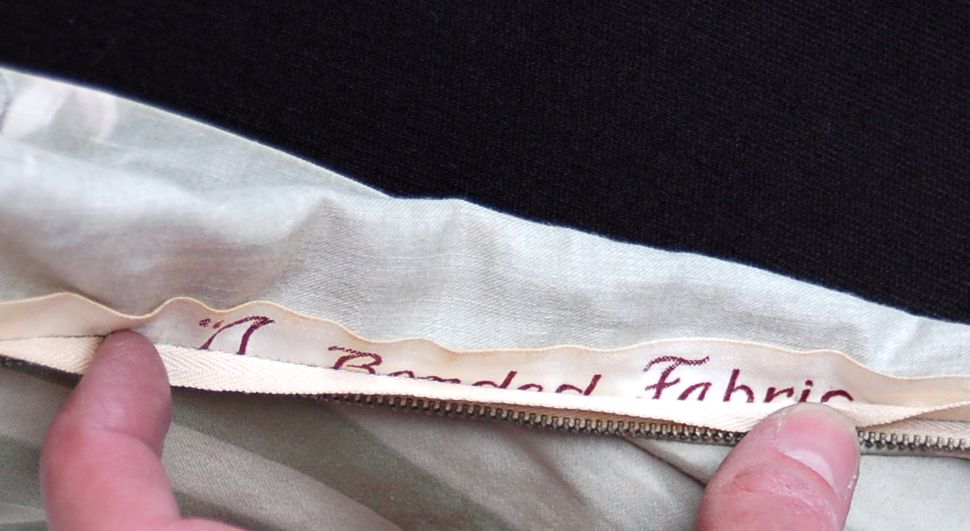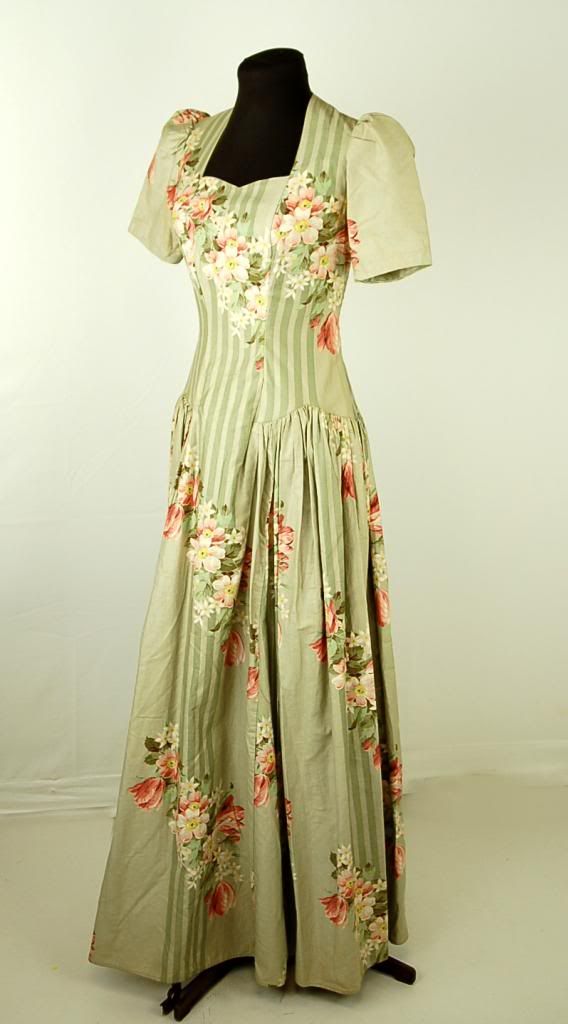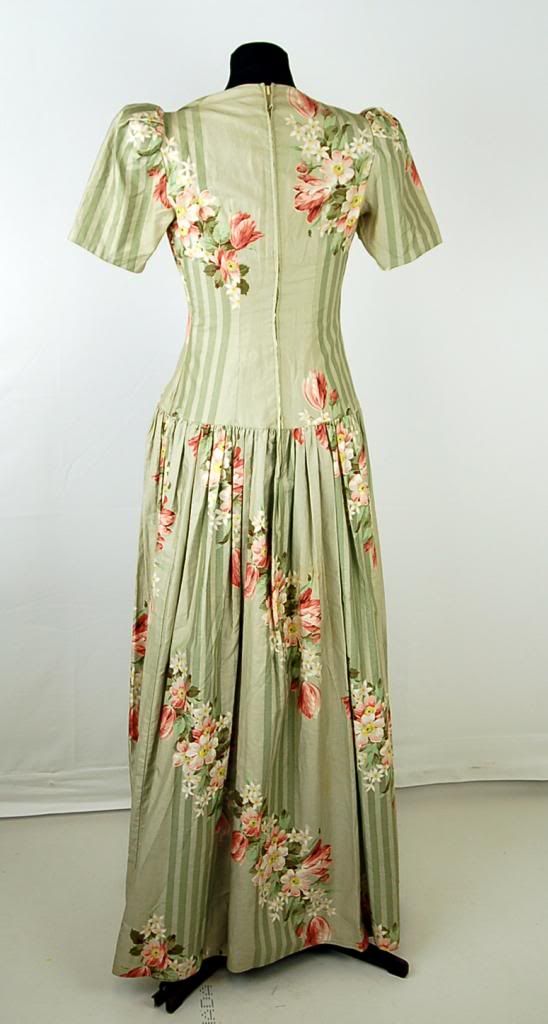Navigation
Install the app
How to install the app on iOS
Follow along with the video below to see how to install our site as a web app on your home screen.
Note: This feature may not be available in some browsers.
More options
You are using an out of date browser. It may not display this or other websites correctly.
You should upgrade or use an alternative browser.
You should upgrade or use an alternative browser.
Question about 40s dress fabric - "A Bonded Fabric"
- Thread starter zannew
- Start date
Bonded fabric is layered (compound) fabric with the two bonded by adhesive. Usually the outer fabric is given a light backing layer.
This dress really doesn't look like a candidate for ever having such a layered effect.
Bonded thread (from The Fairchild's Dictionary): A smooth, special type of compact yarn or cord, generally plied, characterized by a combination of twisting and bonding or welding. Some bonded threads are made of a single cord, while others are made from several cords.
The only other possibility I can think of is A Bonded Fabric being a trade name.
This dress really doesn't look like a candidate for ever having such a layered effect.
Bonded thread (from The Fairchild's Dictionary): A smooth, special type of compact yarn or cord, generally plied, characterized by a combination of twisting and bonding or welding. Some bonded threads are made of a single cord, while others are made from several cords.
The only other possibility I can think of is A Bonded Fabric being a trade name.
Cross-posted with Jonathan. I looked at a number of mid-century and earlier sources and can't see the word bonded used at all.
This is an interesting article sent to me by vertugarde, who saw this post:
http://news.google.com/newspapers?i...AAAIBAJ&pg=657,2535380&dq=bonded+fabric&hl=en
It looks like bonded fabrics were first made in about 1958 and really got going in the early 60s.
http://news.google.com/newspapers?i...AAAIBAJ&pg=657,2535380&dq=bonded+fabric&hl=en
It looks like bonded fabrics were first made in about 1958 and really got going in the early 60s.
MyVintageCocktail
VFG Member
That dress is 2 die 4! Love it! And it sure looks to me as if there is a backing (which looks very slightly brushed) bonded to the cotton. Due to the bonding process, you usually can't tell visually that the two layers are separate. (Unless, for example, you're looking at an acrylic or thin wool knit bonded to a jersey-like backing; those often peeled over time.) Your cotton does not look like typical glazed cotton without a backing--it would be more transparent and thinner. I would guess the fabric your dress is made of also feels thicker to the hand than a plain polished or glazed cotton.
Rue_de_la_Paix
VFG Member
Hello,
The term pre dates the late 1950s, I have seen it on older fabric's selvages. It does not refer to any backing or actual "bonding" technique used to make the fabric. It refers to the printing technique used on the fabric. Loosely put, it means the dye or color is bonded with the fibers, to help the the color stay fresh looking after washing and wearing or regular usage. I am pretty sure that I have only seen this term "a bonded fabric" used on printed fabrics (printed with color patterns), not on solid colors or fabrics woven with previously dyed/colored threads. From my memory it goes back to at least the 1940s.
So you could see this term used on various manufacturer's fabrics. I have found it on a variety of fabrics, from polished cottons to barkcloth type fabrics.
The pattern looks mid to late 1940s to early 1950s to me, and I agree it likely is a home decor fabric meant for curtains, light upholstery, etc.
Do you think it could have been made more recently, those sleeves look very 1980s to me. It is very pretty and an interesting use of the fabric.
The term pre dates the late 1950s, I have seen it on older fabric's selvages. It does not refer to any backing or actual "bonding" technique used to make the fabric. It refers to the printing technique used on the fabric. Loosely put, it means the dye or color is bonded with the fibers, to help the the color stay fresh looking after washing and wearing or regular usage. I am pretty sure that I have only seen this term "a bonded fabric" used on printed fabrics (printed with color patterns), not on solid colors or fabrics woven with previously dyed/colored threads. From my memory it goes back to at least the 1940s.
So you could see this term used on various manufacturer's fabrics. I have found it on a variety of fabrics, from polished cottons to barkcloth type fabrics.
The pattern looks mid to late 1940s to early 1950s to me, and I agree it likely is a home decor fabric meant for curtains, light upholstery, etc.
Do you think it could have been made more recently, those sleeves look very 1980s to me. It is very pretty and an interesting use of the fabric.
zannew
Registered Guest
thank you so much Barbara for sharing your experience! Mystery solved. As far as date, I, too thought it looked 80s at first but I am pretty sure it is not. There is a stiffened fabric interfacing at the hips on either side to make them puff out more (I don't know the technical term for that - seems like a "side bustle") and the zipper looks old as well as the thread and shoulder pads. I think it is so pretty!
Thank you all again for contributing to my post.
Thank you all again for contributing to my post.
Circa Vintage Clothing
Alumni
I used to work for a lady who was married just after the War in Scotland - all the islanders put their ration cards together and bought a large quantity of floral chintz, like yours, and it was used to make a wedding gown plus curtains and bedspread. It's an odd idea, for your wedding gown to match the soft furnishings but it was after the War and fabric was scarce.
Your lovely dress shows signs of alterations: the bodice looks like it might have been taken in down the front princess seams, you can see how the stripe is a bit off and the seam isn't straight.
Your lovely dress shows signs of alterations: the bodice looks like it might have been taken in down the front princess seams, you can see how the stripe is a bit off and the seam isn't straight.
Better Dresses Vintage
Alumni
This wouldn't be the first case of someone making a dress out of curtains  .
.
Looks like polished chintz to me, which is usually used for home decor, but then, my mom often uses "upholstery" fabrics for dressmaking because it's wider and often, more luxurious.
I remembered something about "bonded" having to do with a printed design being "bonded/fused" onto the fabric, rather than woven in, but as it was only some vague recollection, I kept quiet until somebody confirmed my suspicion.
Scarlett O'Hara makes due:

Carol Burnett makes fun:

 .
.Looks like polished chintz to me, which is usually used for home decor, but then, my mom often uses "upholstery" fabrics for dressmaking because it's wider and often, more luxurious.
I remembered something about "bonded" having to do with a printed design being "bonded/fused" onto the fabric, rather than woven in, but as it was only some vague recollection, I kept quiet until somebody confirmed my suspicion.
Scarlett O'Hara makes due:
Carol Burnett makes fun:


